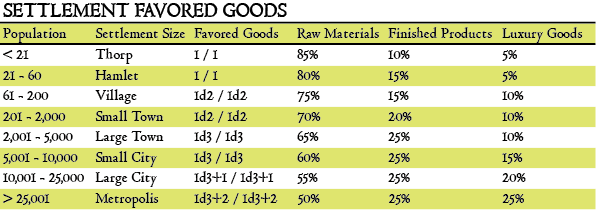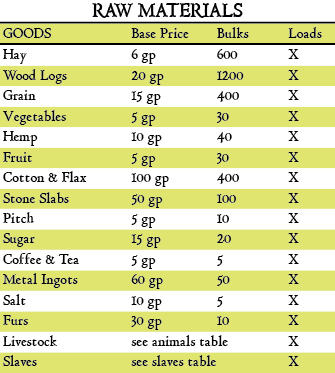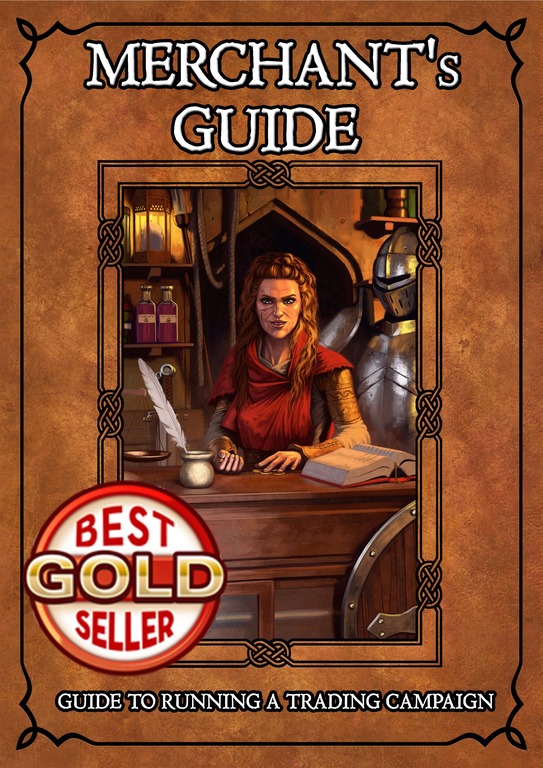Previous article…D&D – Merchant #8 – Price Modifiers
So, here we are with a new article of this series, where we will be talking about Trade Nodes.
We introduced the concept of trade node few articles ago, and now we are going to explain how to create a trade node and how many categories of trade nodes we want.
First, let’s try to explain again…
We have published the awesome Merchant Guide, a pdf available on DrivethruRpg. Just have a look at the preview to have an idea of the content.
Also, if you already have an idea on how to run your own trading campaign you may want to have a look at our Trade Goods Generator.
WHAT IS A TRADE NODE
A trade node is a place where people buy and sell goods. Nothing more, nothing less.
However, for the sake of our project, we will make coincide a trade node with a settlement.
Of course some trade node will be more important than others, and usually the bigger a settlement is, the more important the trade node is.
Potentially, a trade node may sells and buys any trade good among those listed in the table of trade goods we compiled.
However, a trade node possesses favored trade goods; in other words, a specific good – or more than one – that the settlement prefer to sell or prefer to buy.
High demand and high offer.
Imagine a settlement that has high demand of tobacco; this translates into a positive price modifier for the good named tobacco.
The same settlement, may be a producer of silk; this translates into a negative price modifier for the good named silk.
It doesn’t mean that the settlement buys tobacco exclusively, or sell silk and nothing else.
It means that if the merchant is dealing to buy or sell tobacco, he is going to pay or gain, a higher amount of coins.
Beyond that, the settlement may trade any trade goods available in the list.
We will see more when talking about buying and selling goods, in future articles.
HOW TO CREATE A TRADE NODE
We need two information to create a trade node.
1) We need to determine the size of the settlement. The size of the settlement will help us to determine the magnitude of point 2).
2) We have to roll randomly the favored goods for which the trade node has high demand and high offer, keeping in mind that a big settlement will have more favored goods.
Size of the Settlement
We have plenty of choices here. The one I prefer however, is the one given by Pathfinder, which has eight size of settlement. I think they will work fine.
Pathfinder provides the following sizes:

So, this table helps us determine the size of the settlement and it also includes a category name. I can change the level of population of course, but for now this will work fine.
Favored Goods
This part is a bit more tricky.
I want that, accordingly to the settlement size, to have more or less favored goods.
A hamlet for example, will have less goods with high demand or high offer than a small town or a large city.
We have to choose if we want roll the number of favored goods, or we want them to be constants…
…or we can employ a mixed system!
Where small settlement have a constant number of favored goods, while larger ones have a variable number.
We want even more.
A small settlement is more likely to have favored goods belonging to the raw materials category than the luxury goods category, while a large settlement is more likely to have favored goods belonging to the luxury goods category (or finished products) than the raw materials category.
All in the same table of course, because we must keep the growth of table under control, as much as we can.

Favored Goods: This column presents two numbers. The number on the left represents the number of favored goods that have high demand and thus a positive price modifier. The number on the right represents the number of favored goods that have high offer and thus a negative price modifier.
Raw Materials, Finished Products and Luxury Goods: This the chance a favored good belongs to a specific category. A Thorp has 85% of having a favored good belonging to the raw material category, however there is a 10% chance that the good is
a finished product, or a 5% chance that the good is a luxury good.
Rolling the Favored Goods
Now that we know how many and which favored goods a settlement has, we only need to roll them randomly.
We already have a list of each good, we saw it in previous articles, but we post them here again.



We need to assign a probability to each good, and we want to use a d100 of course.
These are the basic ideas on how to create a trade node.
Next Article…D&D Trade Campaign #10 – Buy & Sell Trade Goods
